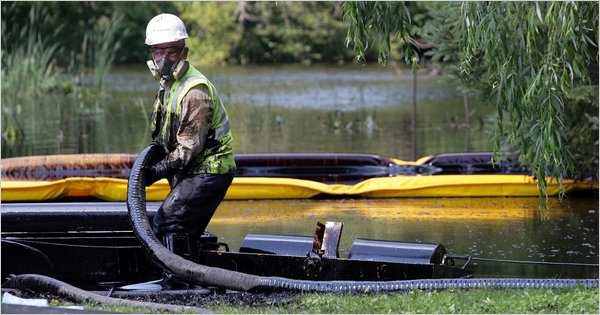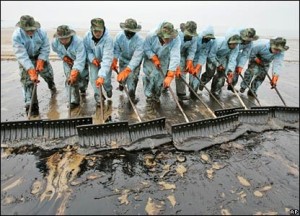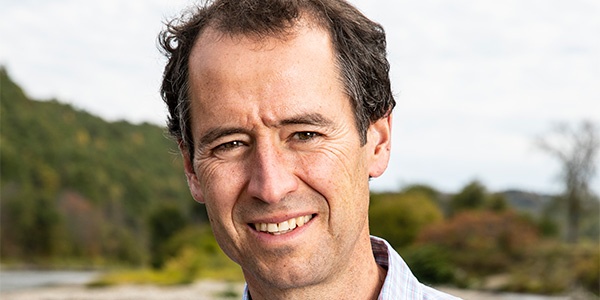We have much more to do and your continued support is needed now more than ever.
Big Oil’s Big Plans for Tar Sands in New England
Big Oil, you just can’t trust it.
 In 2008, when they thought no one was watching, oil companies Enbridge and the Portland Montreal Pipeline Company hatched a plan to reverse the flow of two existing pipelines to send dirty tar sands crude through Ontario, Quebec, and into Vermont, New Hampshire and Maine for refining along the East Coast and Gulf Coast and export abroad. The plan would have exposed American treasures to the risks of a tar sands oil spill. These include Sebago Lake, which supplies Portland, Maine with its drinking water; the Connecticut River, New England’s largest; the Misissiquoi River, historically valuable to tribes and tributary of Lake Champlain; and other critical resources. It also would have provided another fuse to set off the tar sands carbon bomb by giving this land-locked resource access to markets abroad and in the U.S.
In 2008, when they thought no one was watching, oil companies Enbridge and the Portland Montreal Pipeline Company hatched a plan to reverse the flow of two existing pipelines to send dirty tar sands crude through Ontario, Quebec, and into Vermont, New Hampshire and Maine for refining along the East Coast and Gulf Coast and export abroad. The plan would have exposed American treasures to the risks of a tar sands oil spill. These include Sebago Lake, which supplies Portland, Maine with its drinking water; the Connecticut River, New England’s largest; the Misissiquoi River, historically valuable to tribes and tributary of Lake Champlain; and other critical resources. It also would have provided another fuse to set off the tar sands carbon bomb by giving this land-locked resource access to markets abroad and in the U.S.
To learn more about the threat of tar sands to New England, see this fact sheet.
In 2009 the plan was shelved due to the poor economy. Now it’s back. And Big Oil won’t tell you about it.
That’s because Canada’s dirty secret has gotten out. Tar sands are an environmental disaster. As James Hansen put it, tar sands are a climate bomb that would add 120 parts per million of carbon dioxide into the atmosphere, enough to catapult us past a host of dangerous climate tipping points. Tar sands development is also turning North America’s bird nursery into a toxic waste zone, leading to the decline of caribou in Alberta, and responsible for a tragic and misguided plan to kill thousands of wolves to “protect” caribou instead of forcing Big Oil to stop destroying caribou habitat.
 And then there is the risk of spills. When Line 6B ruptured in Michigan in July of 2010, 1.2 million gallons of oil–enough oil to cover over three acres of land with a foot of oil–spilled into the Kalamazoo River. The cost of clean-up has been 18 times per liter as that of already expensive conventional oil spills, while sticky tar sands still coats portions of the river’s bottom and the spill has left many residents sick.
And then there is the risk of spills. When Line 6B ruptured in Michigan in July of 2010, 1.2 million gallons of oil–enough oil to cover over three acres of land with a foot of oil–spilled into the Kalamazoo River. The cost of clean-up has been 18 times per liter as that of already expensive conventional oil spills, while sticky tar sands still coats portions of the river’s bottom and the spill has left many residents sick.
Now that they are being watched, Big Oil wants to hide the ball. But their plans to bring tar sands to New England are becoming increasingly clear.
First, in summer of 2011, Enbridge announced plans to partially reverse the flow of Line 9, the first of the two pipelines in the original “Trailbreaker” proposal. Last week, before Canadian hearings on the partial reversal have even occurred, Enbridge announced a plan to fully reverse the flow of the Line 9 pipeline all the way to Montreal. And Enbridge finally conceded that diluted bitumen (the especially corrosive form of tar sands) was slated to be transported through Line 9. Assuming Canadian officials increasingly beholden to Big Oil will rubberstamp these plans, Enbridge is now one step away–reserving the flow of the Portland-Montreal pipeline–from bringing tar sands to New England.
 New England can’t afford to have Big Oil’s attempt to sneak tar sands through the region succeed. In July, New England Governors and Eastern Canadian Provincial Premiers are meeting in Burlington, Vermont. Vermont Governor Peter Shumlin is hosting. Governor Shumlin has been a true leader on energy issues and climate. He also understands that the Connecticut River cannot become the next Kalamazoo.
New England can’t afford to have Big Oil’s attempt to sneak tar sands through the region succeed. In July, New England Governors and Eastern Canadian Provincial Premiers are meeting in Burlington, Vermont. Vermont Governor Peter Shumlin is hosting. Governor Shumlin has been a true leader on energy issues and climate. He also understands that the Connecticut River cannot become the next Kalamazoo.
In a recent meeting preparing for the July event, Governor Shumlin said,
“I don’t think that we’ve dug deep enough in terms of really having a plan that’s going to enrich us all and make New England and the Northeast provinces the place where we get energy right. We have that opportunity; the planning for that opportunity is in your hands.”
The meeting will focus on a climate change plan endorsed by the Governors and Premiers to reduce greenhouse gases by 10 percent below 1990 levels by the year 2020.
Getting energy right, protecting New England from an environmental calamity like the Kalamazoo spill, and reducing carbon pollution means keeping New England tar sands free and denying tar sands’ companies the market access they crave. At the July meeting, the Governors and Premiers need to discuss the threat of tar sands to New England and set a goal of keeping New England tar sands free.
Governor Shumlin is right, New England has an opportunity to get energy policy right, and that opportunity is in our hands. Big Oil wants to snake tar sands into the Northeast. They are hoping we won’t notice. We can’t afford to let that happen.
![]() Click here to help protect Northeastern wildlife from dirty tar sands oil.
Click here to help protect Northeastern wildlife from dirty tar sands oil.






















